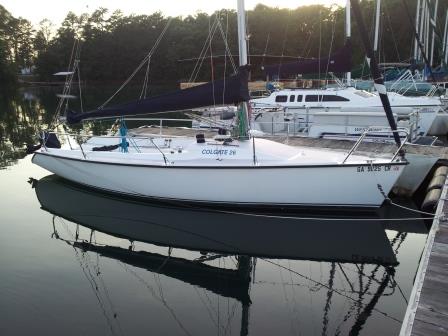
Breaking News
Main Menu
Colgate 26 Owners Manual
вторник 06 ноября admin 59
Comparing the H260 to similar sailboats A powerboat take you to a destination, a sailboat will take you on a journey. There is an international design standard for recreational sailboats. Tpb download movies games. Boats are divided into categories based on certain parameters in respect to stability, buoyancy, and other relevant handling characteristics. These categories are: Category A - Ocean; Extended voyages with wind force in excess of Beaufort force 8, and significant wave height of 4 meters or above. Category B – Offshore; Off shore voyages in possible wind force of Beaufort force 8 and significant wave heights of up to 4 meters. Category C – Inshore Voyages on coastal waters, large lakes, bays estuaries, or rivers, where wind force of up to force 6 on the Beaufort scale and significant wave heights of up to 2 meters may be experienced. Category D – Sheltered waters. Designed for voyages on sheltered inland waterways, including lakes, rivers and canals, where wind force 4 and significant wave height of 0.5 meters may be experienced.
Jun 20, 2018 - Colgate 26 keelboat designer and company owner Steve Colgate, announced that the website to support the Colgate 26 has been updated. Buy: $ GMC Savanna Owner’s Manual Book Oem W/ Bifold Case & Supplements VG Buy: $26.95 Time Left: 2 days, 19 hours, 10 minutes and 28 seconds Other Car Manuals - Meadville,PA,USA.
The H260 is a stable and safe Category 'C' boat. Although the heaviest of the “Clorox Bottles” at 5,000 lbs displacement, it is not suitable for offshore sailing.
I'm not interested in offshore sailing and I don't know of any Cat B boats that can realistically be pulled by a medium size pickup. For more on towing. People have rowed across the Atlantic in category 'D' boats but these exceptions needed extensive preparation and precautions and a seriously demented owner with a death wish. A reasonable definition of an offshore sailboat is one that is at least 8,000 displacement, solid keel with low center of gravity, capsize ratio below 2.00 and vanishing stability over 140 degrees. This is hard to achieve in a trailerable boat which is why the H260 and its cousins are Cat C boats. There are a few small 'trailerable' boats that meet the Cat “B” criteria.
Most notable is the which runs well over $100,000 new. There are bound to be others but I don’t know them. If you are aware of any. One of the things that makes the H26/H260 unique is that it is a water ballast boat. There is some bias against water ballast boats in the sailing community. However, water ballast is used in large as well as small boats and has been proven to provide an excellent design alternative for trailerable boats.
Go to for more on water as ballast for sailboats. Although some people are swayed by the color of the cushions and how many heads there are, chart chart below provides a starting point for comparing some of the factors involved in sailboat design. Data obtained from: Use these numbers with caution - Do your own calculations using the above links. Data on some of these boats is hard to come.
This summary is only presented to give a general idea of how to go about comparing the relative differences between boats. Some comparisons are more significant or valid than others -- especially when dealing with small boats. For example, it is fairly easy to compare the SA/D between boats to determine performance in light wind, but comparing the capsize ratios is questionable. I've put the Dana 24 and the Colgate 26 in this mix to give an idea of how conventional keel boats compare to water ballast.